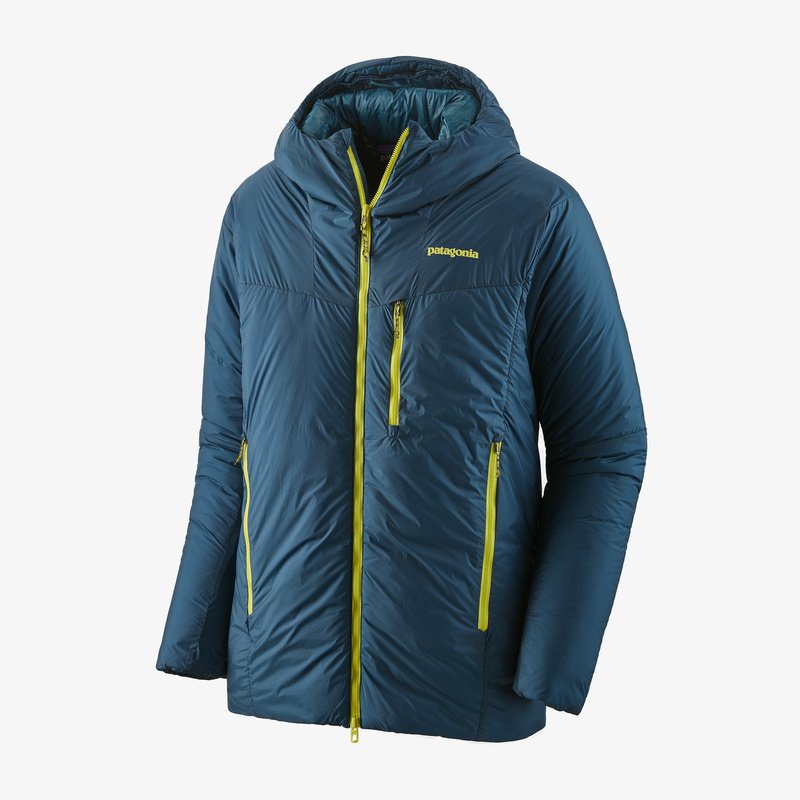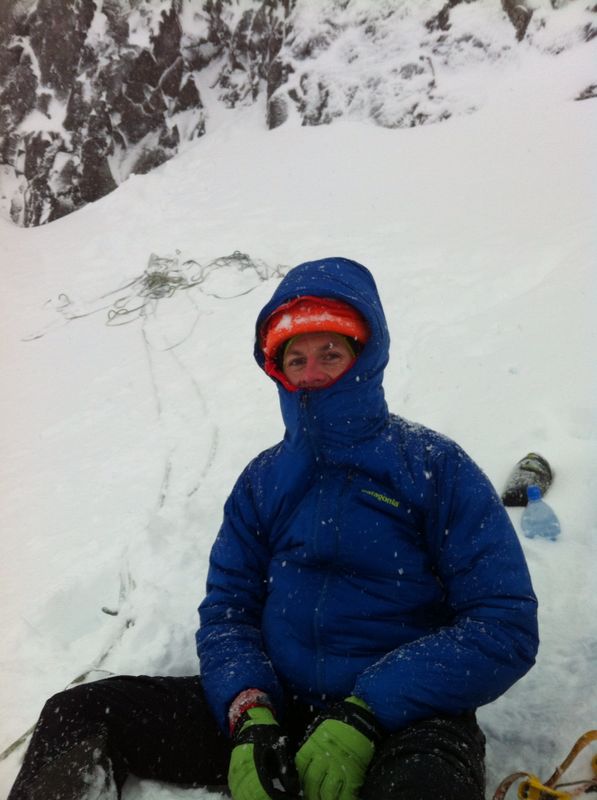
PLEASE NOTE: This is a review of an old version of the DAS Parka. To read our review of the current Patagonia DAS Parka 2020 click HERE
Kev Avery puts a classic piece from Patagonia through its paces. The DAS Parka belay jacket…
Performance****
Style ****
Value****
Patagonia say this about their current DAS Parka: “For full-on alpine conditions, the DAS Parka is our warmest insulated jacket; it’s made with high-loft 120-g PrimaLoft® SYNERGY insulation throughout, additional 60-g PrimaLoft® ONE insulation in core areas, and a lightweight, PU-coated nylon ripstop shell that is durable, water-resistant and windproof.”

This is my second ever DAS Parka and Patagonia’s most recent incarnation of their classic synthetic belay parka. I bought my first in the Patagonia store on Oahu’s North Shore, it was 40 degrees centigrade at the time, and humid as hell so it wasn’t needed at that point, but the exchange rate made the purchase a ‘no brainer!’ I wore that DAS literally to death and it came with me on lots of adventures in Scotland and the Alps. When it did die I made use of Patagonia’s “Ironclad Guarantee” and was given a credit as they were not currently making the DAS. So, when I saw the DAS was back in the range, I was pretty psyched to try the new one!
BY the way, DAS stands for Dead Air Space. Basically you want it to trap lots of air, so it should hopefully be well named.
One thing I do remember about my old (circa 2004) DAS is that the sizing was huge! If you read our Belay Jacket Article you will already know that a good belay parka should fit over the top of your shell layers and this would explain the oversizing of the DAS. But this original one was massive and I actually opted for an XS size, and even this was fine over the top of everything.
So, one of the first things I noticed in the bumf from Patagonia, was that the new DAS was paired down in terns of fit. So, I opted this time for a size Small. And having used the DAS quite a bit now, I feel this was a good choice for me. I am 5 feet, 9 inches tall, about 65 kg and when I’m climbing I generally wear quite light and thin layers. Typically for technical climbing in winter I’ve got a baselayer wicking top, fleece midlayer and then a light shell. I may wear a synthetic gilet to insulate my core if things get really cold. The DAS fits easily over this ‘action suit’ and as such fulfills my first main requirement of a belay parka. It is also long enough so as to insulate my hips and glutes and the crucial 2 way zipper allows this to work, even over my climbing harness.

Okay then…so far the fit is all good! Patagonia say it is more sculpted but I wouldn’t go as far as to say it is tailored as such, except maybe tailored in quite a boxy way to do a practical job, which is perfect for the kind of garment it is.
Keeping on with the fit theme, I liked the sleeve length and the simple elastic cuffs (others may prefer velcro). The hood was also very good, easily fitting over my Petzl Sirocco climbing helmet. Adjustment was also pretty simple, being via a single-pull drawcord to adjust overall volume and peripheral vision. This was easy enough to operate with big gloves on too. My one gripe with the fit and cut was the collar and neck. It did not seem to fit in with the ‘tall collar traps extra heat’ description on the Patagonia site and I have read other reviews which say the same thing. In my opinion it stops about an inch and a half too low to fully seal out the cold and damp, grim weather that has been thrown at it this winter in Scotland and the Alps. To get it to actually cover my face it actually pulled the shoulders up a little so a bit of tweakage is required in the design here I think.
A few finer details…
The 2 way zipper works smoothly even with gloves on. It doesn’t snag on the internal baffle and this baffle does a good job of sealing out wind. The two hand warmer pockets are operated with zips which again, are easy to use whilst wearing gloves as is the chest pocket, something which is handy for stuffing some food in to nibble on, whilst your mate is climbing. There are also 2 internal mesh pockets, a key feature on this type of parka. These are big enough to store spare gloves, a topo or even a 1 litre Nalgene type drink bottle.
The fabric Patagonia use on the current DAS is:
“1.2-oz 20-denier 100% nylon PU-coated ripstop, with a DWR (durable water repellent) finish. Lightweight PU-coated nylon ripstop shell is durable, water-resistant, windproof and treated with a DWR (durable water repellent) finish.”
It is supposed to be more water resistant and windproof due to the PU coating but this will compromise breathabilty a little I would have thought. It does seem durable though and pretty light. I’ve metaphorically kicked mine around quite a bit and it’s holding up fine. Back onto weight and it hauls in just under the 700g mark for my Small, a little lighter than my old DAS. The construction of the new DAS is much less of a stitch through one and this definitely helps eliminate cold spots in the insulation so this is a positive step.
Okay, so here is the BIG question. How warm is it?
Well firstly, this is kind of a relative thing as how warm something is to one person can feel totally different to another. Probably best to think in terms of insulation and fill, and then try and relate this to your own experiences and comparisons with other garments that you may have used.

One key thing for the whole ‘action suit’/’belay parka’ system to work is that you need the layers to be more breathable the further a way from the body that they are. So, as the DAS is essentially going to be your outer layer, it needs to be pretty dam breathable. We’ve already talked about the PU coated fabric and the breathability trade off there, so what about the actual insulation?
Patagonia use, “120-g PrimaLoft® Synergy 100% polyester” throughout the DAS (arms, body hood etc) then in the torso an additional layer of “60-g PrimaLoft® ONE 100% polyester” (essentialy adding a 60-g filling gilet to keep the core warm). Some have said already that the current DAS isn’t as warm as the old DAS and that is one of the ways Patagonia have managed to reduce the weight. I’m not so sure and out of all my current (similar weight, fill etc) belay parkas, this current DAS is without a doubt, the warmest. I can’t really give a scientific explanation other than what I have used these garments for, and how they feel for me. The DAS is also the lightest of the similar garments I have used.
You’ll notice that Patagonia have used 2 different types of Primaloft in the DAS. The main component is Primaloft Synergy, which as far as I can tell is a cheaper inferior fill to Primaloft One, meaning you get less warmth for weight? I’m not sure this sounds like the best reasoning to go with this insulation, although some have also reasoned that Synergy is more breathable than One, hence why the layer of One is on the inside? Others have also reasoned, that Synergy is more durable and repels water more readily, but is less compressible. Perhaps Patagonia acknowledge this as the stuff sack they provide is HUGE! At least the DAS goes in easy though! There is a great discussion about all of this on the Cold Thistle Blog for those of you who are more interested.

Also for those of you who are wondering why Patagonia don’t use down in the DAS, then read our Belay Jacket Article. They do actually make a hydrophobic down jacket, The Encapsil, but this is over twice as expensive and still won’t provide the performance of a DAS in damp/wet environments. When I was reading up on some background stuff for this DAS review I came across Kelly Cordes’s blog (yeah I know he works for Patagonia!) who had this interesting analogy about down versus synthetic:
“Think of it like women (or men – all about equality here). High-maintenance chicks suck. It’s a big drawback. Even if they’re hot. It’s like a down jacket. It doesn’t matter how comfy or nice looking it is, in the long run you’ll end up a beaten-down man with the thousand-yard stare, shivering and cold and lonely and broke and hating the world. For a quick session, though? (Meaning a day at the crag, get your mind out of the gutter!) Oh yeah.
But I’m in it for the long haul, baby.”
An amusing but meaningful analogy I thought…
Finally, I’m delighted to see that Patagonia have finally brought out a female version of the DAS. You can see that one on their website.
Okay let’s sum things up. The new DAS has been a great belay parka for me this winter. The only thing I would like to see is a higher collar so the coverage protects my mouth, face and chin better. The hood itself is fine and works over a helmet. I like the cut (it isn’t a fashion jacket), the 2 way zip, the inner and outer pockets and the lack of stitch through construction.It is also warm enough for me and light enough for the warmth it provides. There are still some questions re the insulation, and I don’t have the full answers yet. At £280 it is reasonably good value for the warmth it offers, and you also benefit from the Ironclad Guarantee that Patagonia offer.
- RRP: £280
- Find out more on the Patagonia website.



2 comments